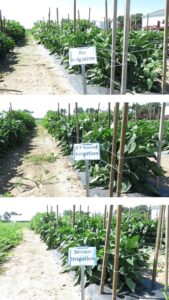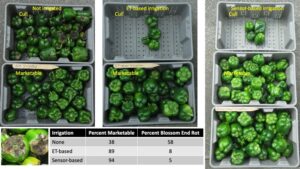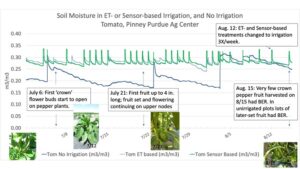At Pinney Purdue (PPAC) bell peppers were harvested for the first time on August 15. Plants appear a little larger in the irrigated plots than in the unirrigated plots, but it is not obvious in photographs (Figure 1). Similar to what was observed at SWPAC, blossom end rot (BER) was much more common in the unirrigated treatment than in the two irrigated treatments (Figure 2). More than half of the fruit from the unirrigated plot had BER, and only 5% to 8% of fruit in the irrigated treatments had BER.

Figure 1. Pepper plots in irrigation demonstration plots at Pinney Purdue Ag Center at the time of of first harvest on 8/15/2022. Treatments were 1) no irrigation, 2) irrigation based on evapotranspiration estimates for tomatoes, and 3) irrigation based on soil moisture sensors installed in tomato section of bed.

Figure 2. Cull and marketable fruit harvested from unirrigated pepper plants, or from plants irrigated based on evapotranspiration (ET) estimates or soil moisture sensor measurements. First harvest on 8/15/2022 of ‘Tarpon’ pepper transplanted on June 6, 2022. Unreplicated demonstration at Pinney Purdue Ag Center, Wanatah, IN. 21, 15, and 20 plants harvested in unirrigated, ET-based, and sensor-based treatments, respectively.
The first fruit to set on the plants, located at the first fork of the stem, rarely had blossom end rot. Some of the later-set fruit with BER in the unirrigated plot had not yet reached marketable size. In the irrigated plots, most of the immature later-set fruit did not have BER, and so they were left on the plant to reach marketable size.
We did not monitor soil moisture in the peppers, but soil moisture measured in the tomato section of the same bed suggests patterns we would expect under the peppers. In the second week of July, when the first pepper fruit was setting, the soil moisture in the unirrigated bed decreased from about 0.25 m3/m3 to just below 0.20 m3/m3. In the irrigated treatments, moisture remained above 0.26 m3/m3. As described above, few fruit set around this time developed BER. Over the next week and a half, from July 13 to 24, soil moisture in the unirrigated plot remained below 0.20 m3/m3, and in the irrigated plots soil moisture was maintained above 0.27 m3/m3. During this period pepper plants continued to flower and set fruit at higher nodes. After a rain on the 24th, the unirrigated plot dried down to below 0.20 m3/m3 after several days. Given that lack of soil moisture can promote BER, it seems likely that fruit set during these dry periods are the ones showing BER. Rain in early August wet the soil profile in all the treatments. If the plots are maintained for a few more weeks it will be interesting to see how much BER shows up in later harvests.

Figure 3. Observations on pepper development and soil moisture measured by electronic sensors at 12 inch depth in tomato plots irrigated based on evapotranspiration (Et-based), soil moisture sensors, or not irrigated. Pinney Purdue Ag Center, July 1–Aug. 15, 2022.
Funding for project Improve Drip Irrigation Management for Vegetables and Melon Production in Indiana was made possible by the Indiana State Department of Agriculture through grant A337-22-SCBG-21-003. Its contents are solely the responsibility of the authors and do not necessarily represent the official views of the ISDA.